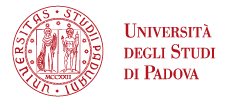PRIN 2022 PNRR / Elena Barbera

Acronimo: SAME
Titolo: Sustainable Antioxidants for Microalgae Exploitation
Responsabile scientifico: dott.ssa Elena BARBERA - Dipartimento di Ingegneria Industriale-Università' degli Studi di PADOVA
Coordinatore: prof. Nico BETTERLE - Università degli Studi di Verona
Partner-Unità di ricerca: Università degli Studi di Bologna, Dipartimento di Ingegneria Industriale-Università degli Studi di PADOVA
Bando: PRIN 2022 - Decreto Direttoriale n. 1377 del 01/09/2023
Durata: 30/11/2023 - 29/11/2025 (24 mesi)
Budget totale progetto: € 219.566,00
Abstract del progetto
"Can a cultivation of fast-growing microalgae finally become economic and environmentally sustainable by producing valuable nutraceuticals?". Results from the SAME project will answer this question. The idea arises from the evidence that microalgal cultivations are a resource for food and feed with high potential, but they have some major obstacles such as low cell densities and moderate growth rates. These two factors are often fatal for the economical sustainability of the farm plants, already burdened with high maintenance and processing costs.
Finding alternative strains, more performing than already available ones, is of utmost importance. The prokaryotic microalga Synechococcus sp. PCC 11901 has been recently isolated and showed game-changing properties, suitable for large-scale cultivation. In fact, using light and CO2, Synechococcus sp. PCC 11901 a) is capable of accumulating biomass in large quantities, b) has a rapid duplication rate, c) tolerates high salinity, and d) is genetically manipulable.
Prokaryotic microalgae naturally accumulate high amounts of antioxidants (AOXs), which, upon purification, can be added to valuable nutraceutical formulations. Most abundant AOXs in Synechococcus sp. PCC 11901 belong to three major classes: a) phycocyanin, b) carotenoids and c) tocopherols. One of the main goals of the SAME project is to synthesize the non-native astaxanthin in Synechococcus sp. PCC 11901. This is because such a carotenoid has well-documented health effects, becoming the microalgal metabolite of the highest value (> 4000$/kg). A genetic engineering approach will be implemented to achieve this goal. In parallel, a second metabolic engineering approach will be conducted to enhance the accumulation of another important AOX, namely α-tocopherol (Vitamin E). Accumulation of these two metabolites, important for both nutraceutical and pharmaceutical uses, will strongly increase the added-value of the microalgal biomass.
In SAME, growth of Synechococcus sp. PCC 11901 in a continuous system will be tested, aiming to optimize biomass and target AOXs accumulations. Continuous systems allow to reach steady-state conditions, resulting in a stable and higher productivity compared to batch ones. Moreover, "green" approaches will be investigated for cell harvesting and target metabolites extraction. In fact, the final goal of SAME is the development of sustainable protocols for the recovery of bio-based and bio-active compounds. All the results will be used to develop large-scale material and energy balances, to preliminarily evaluate the economical and environmental sustainability of the process.
In conclusion, the research conducted in the SAME project will represent a landmark for a sustainable and full exploitation of microalgal potentials. The acronym SAME indicates that the AOXs produced in engineered Synechococcus sp. PCC 11901 are equal to the same AOXs produced in conventional ways. SAME will provide target products in a smarter and more sustainable way.





